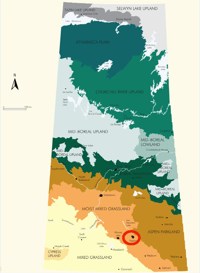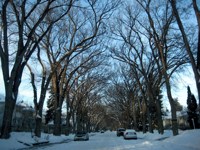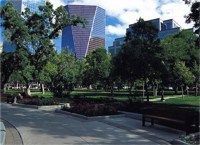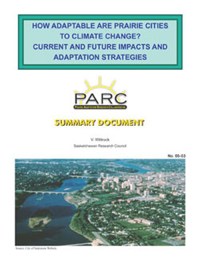Regina
Community Assessment & Adaptation Options:
Regina is located in south-central Saskatchewan along Wascana Creek within the Moist Mixed Grassland Ecoregion. Regina is Saskatchewan's second largest city, the provincial capital, and a thriving manufacturing, retail, service and distribution centre. The city largely relies on its water supply from Buffalo Pound Lake, which in turn is fed from Lake Diefenbaker along the South Saskatchewan River system. Treated wastewater is released into the Qu'Appelle River system. The urban forest has been planted, and streets lined by American Elm (Figure 2) are a significant attraction as is the recently dredged Wascana Lake. Wascana Centre is a 376 hectare park on Wascana Lake and encompasses numerous tourist attractions of provincial stature: the Legislature, Science Centre/Imax Theatre, Royal Saskatchewan Museum, McKenzie Art Gallery and the University of Regina. Regina provides other major tourism and entertainment attractions year-round including Agribition, Farm Progress Show, Casino Regina and the Saskatchewan Roughriders football club.
The Moist Mixed Grassland Ecoregion is home to over 55% of the provincial population, and encompasses other major urban centres including Saskatoon, Moose Jaw, Weyburn and Estevan. The ecoregion is dominated by agriculture, being approximately 80% cultivated. Numerous dams and reservoirs are present. Other economic activity includes production of oil and gas, potash, salt and coal. Natural vegetation is primarily mid-grasses and short-grasses with aspen woodlands restricted to sloughs and coulees. Aspen stands have been expanding as a result of a reduced incidence of wildfire. Native habitat and cropland are important wildlife habitat for upland mammals and waterfowl.
Climate Normals (1971-2000)
- The average daily temperature ranges from -16.2°C in January to 18.8°C in July, with 5 months being below 0 (November to March). The lowest average daily minimum temperature is -21.6°C experienced in January and the highest average daily maximum temperature of 25.7°C is experienced in August.
- The annual precipitation is about 388.1 mm of which 78% is rainfall and the remainder is snow. 56% falls in the months of April, May, June, July.
- The average monthly wind speed is between 16.1 (July) and 20.3 km/hr (April)
- An indication of the demand for cooling and heating is provided by the number of degree days above 18°C - 145.7; and the number of degree days below 18°C - 5660.
- There are a total of 2338 sunshine hours per year with a minimum of 22 days with measurable sunshine in December and over 30 days in July.
Future Climate
Over the century to 2100 climate scenarios suggest:
- A warmer climate - temperatures may generally rise 2 to 4 degrees.
- A longer growing season - but drier, despite an increase in precipitation to about 400 to 450 mm. This is a result of increased temperatures and increased evapotranspiration.
- The demand for summer cooling could increase almost 2 to 2.5 times.
- A shorter, milder winter. Heating requirements may be reduced by 14% to 22%.
- Expect more frequent and more intense extreme events (e.g. heavy precipitation or drought). Droughts will likely increase in intensity and frequency.
- Expect an increase in the number of freeze/thaw days.
Regional Adaptation Options
- Under climate change, the primary issue for communities will be water and sewer management to handle both flood and drought situations.
- Xeriscaping (low water landscaping; see City of Regina webpage) and urban forest retention should be priorities. This may require introducing new plant species, changes to irrigation schedules, and pest management adjustments.
- Adopt appropriate road maintenance type and scheduling to minimize surface deterioration associated with more frequent freeze-thaw cycles, and address more frequent icey road conditions.
- Monitor park vegetation and manage for potential increased use.
- Ensure emergency preparedness plans address extreme weather events (such as heat waves) and associated health risks. The city should have a drought management protocol in place.
- Agricultural priorities in the region will continue to be soil and moisture conservation and stocking rates and/or grazing periods may have to be adjusted.
- The outdoor ice rink season will shorten. On the other hand, a longer warm season increases tourism and cultural opportunities.
Sources of Additional Information:
The following documents advise on adaptation and communities:
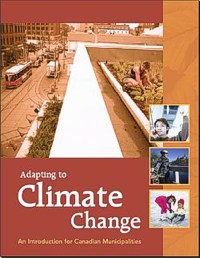
Adapting to Climate Change: An Introduction for Canadian Municipalities
A tool that will help municipalities and communities develop a better understanding of adaptation. It represents a starting point for municipalities and communities that have not yet formally considered adaptation in their planning processes. For municipalities and communities already engaged in developing adaptation mechanisms, it can be used to enhance understanding of adaptation throughout the local decision-making community.
Sources:
- Acton, D.F., Padbury,G.A., Stushnoff,C.T. (1998): The Ecoregions of Saskatchewan. Canadian Plains Research Center, University of Regina and Saskatchewan, Environment and Resource Management.
- Barrow, E. (2009b): Climate Scenarios for Saskatchewan. PARC Summary Document No. 09-01, 15p.
- Barrow, E. (2009a): Climate Scenarios for Saskatchewan. PARC, 131 p.
- Canadian Plains Research Centre (2005): Encyclopedia of Saskatchewan, Ecozones and Ecoregions.
- Environment Canada (2010): National Climate Data and Information Archive, Canadian Climate Normals website; station ID: 3002, Regina
- Mehdi, B. (2006): Adapting to Climate Change: An Introduction for Canadian Municipalities. Canadian Climate Impacts and Adaptation Research Network (C-CIARN). 32 p.
- Saskatchewan (2010): Saskbiz, Community Profiles: Regina
- Wittrock, V. (2005): How Adaptable are Prairie Cities to Climate Change? Current and Future Impacts and Adaptation Strategies. PARC Summary Document No. 05-03, 12 p. [accessed March 18, 2010]
